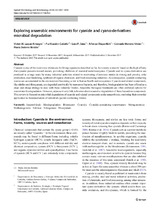Exploring anaerobic environments for cyanide and cyano-derivatives microbial degradation
Autor
Luque-Almagro, Víctor Manuel
Cabello, Purificación
Sáez, Lara P.
Olaya-Abril, Alfonso
Moreno-Vivián, Conrado
Roldán, María Dolores
Editor
SpringerLinkFecha
2018Materia
AnaerobiosisBiodegradation
Bioreactor
Cyanide
Cyanide-containing wastewaters
Metagenomics
Methanogenesis
Nitrilase
Nitrogenase
Thiocyanate
METS:
Mostrar el registro METSPREMIS:
Mostrar el registro PREMISMetadatos
Mostrar el registro completo del ítemResumen
Cyanide is one of the most toxic chemicals for living organisms described so far. Its toxicity is mainly based on the high affinity
that cyanide presents toward metals, provoking inhibition of essential metalloenzymes. Cyanide and its cyano-derivatives are
produced in a large scale by many industrial activities related to recovering of precious metals in mining and jewelry, coke
production, steel hardening, synthesis of organic chemicals, and food processing industries. As consequence, cyanide-containing
wastes are accumulated in the environment becoming a risk to human health and ecosystems. Cyanide and related compounds,
like nitriles and thiocyanate, are degraded aerobically by numerous bacteria, and therefore, biodegradation has been offered as a
clean and cheap strategy to deal with these industrial wastes. Anaerobic biological treatments are often preferred options for
wastewater biodegradation. However, at present very little is known about anaerobic degradation of these hazardous compounds.
This review is focused on microbial degradation of cyanide and related compounds under anaerobiosis, exploring their potential
application in bioremediation of industrial cyanide-containing wastes.

